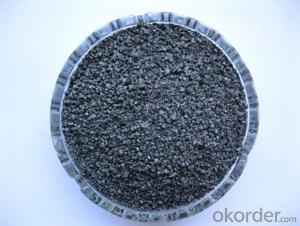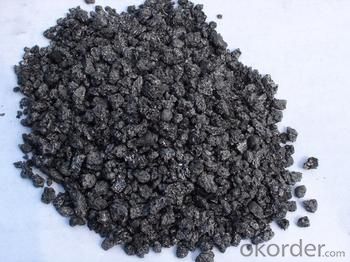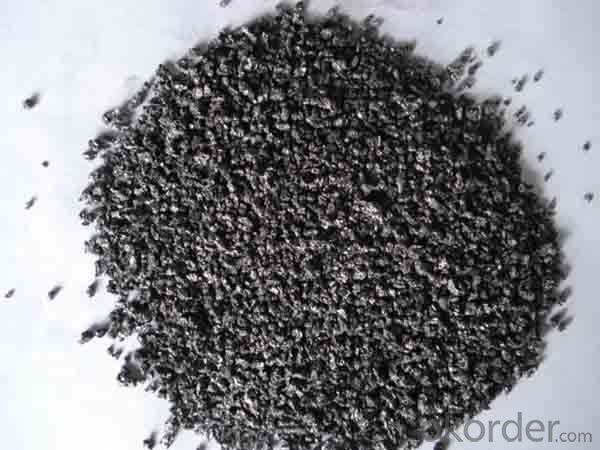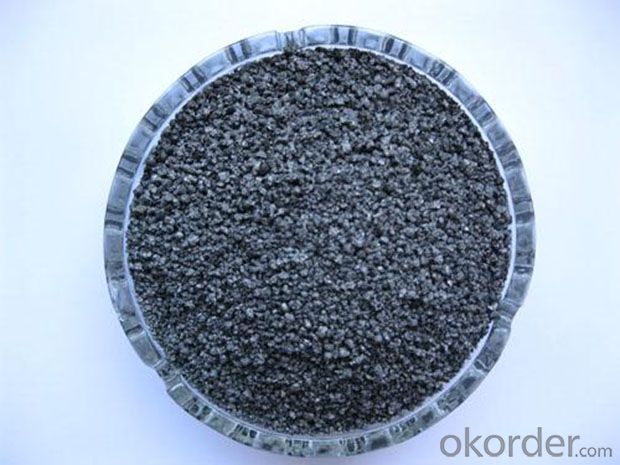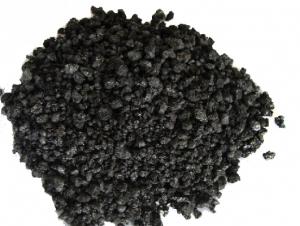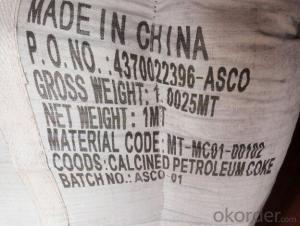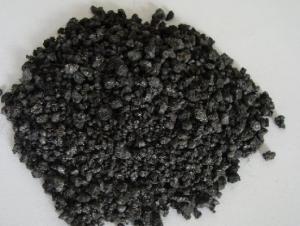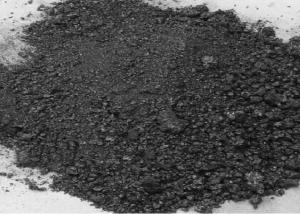FC 98.5 S 0.3 Calcined Petroleum Coke/CPC
- Loading Port:
- Tianjin
- Payment Terms:
- TT OR LC
- Min Order Qty:
- 1 m.t.
- Supply Capability:
- 10000000 m.t./month
OKorder Service Pledge
OKorder Financial Service
You Might Also Like
1.Structure of Calcined Petroleum Coke Description
Calcined Petroleum Coke is made from raw petroleum coke,which is calcined in furnace at a high temperature(1200-1300℃).CPC/Calcined Petroleum Coke is widely used in steelmaking,castings manufacture and other metallurgical industry as a kind of recarburizer because of its high fixed carbon content,low sulfur content and high absorb rate.Besides,it is also a best kind of raw materials for producing artifical graphite(GPC/Graphitized Petroleum Coke) under the graphitizing temperature(2800℃).
2.Main Features of the Calcined Petroleum Coke
High-purity graphitized petroleum coke is made from high quality petroleum coke under a temperature of 2,500-3,500°C. As a high-purity carbon material, it has characteristics of high fixed carbon content, low sulfur, low ash, low porosity etc.It can be used as carbon raiser (Recarburizer) to produce high quality steel,cast iron and alloy.It can also be used in plastic and rubber as an additive.
3. Calcined Petroleum Coke Images
4. Calcined Petroleum Coke Specification
| Place of Origin: | Shanghai, China (Mainland) | Type: | Carbon Additive | Fixed Carbon (%): | 98.5% |
| Brand Name: | CNBM | Model Number: | CNBM | over 2.0: | Real density |
| Working Temperature: | 1300~1400℃ | Dimensions: | 5-10mm | H Content (%): | ≤0.01% |
| Volatile: | ≤0.5% | Ash Content (%): | ≤1% | S Content (%): | ≤0.3% |
| N Content (%): | ≤0.8% | Shape: | carbon particle | Application: | Additives of Metallurgy |
5.FAQ of Calcined Petroleum Coke
1). Q: Are you a factory or trading company?
A: We are a factory.
2). Q: Where is your factory located? How can I visit there?
A: Our factory is located in ShanXi, HeNan, China. You are warmly welcomed to visit us!
3). Q: How can I get some samples?
A: Please connect me for samples
4). Q: Can the price be cheaper?
A: Of course, you will be offered a good discount for big amount.
- Q: What is carbon offsetting in the fashion industry?
- Carbon offsetting in the fashion industry refers to the practice of compensating for the greenhouse gas emissions produced during the production, transportation, and disposal of clothing and accessories. This process involves investing in projects or activities that reduce or remove an equivalent amount of carbon dioxide (CO2) from the atmosphere to offset the emissions generated by the industry. Fashion is known for its significant contribution to environmental degradation, with the production of textiles, manufacturing processes, and transportation all contributing to carbon emissions. Carbon offsetting provides a way for fashion brands and companies to take responsibility for their carbon footprint and work towards reducing their environmental impact. There are various ways in which carbon offsetting is implemented in the fashion industry. One common method is through the support of renewable energy projects, such as wind farms or solar power plants, which generate clean energy and reduce the reliance on fossil fuels. By investing in these projects, fashion brands can offset a portion of their emissions by supporting the production of renewable energy that displaces the need for fossil fuel-based energy sources. Another approach to carbon offsetting is through reforestation or afforestation projects. Trees play a crucial role in absorbing CO2 from the atmosphere, so planting trees or conserving existing forests can help offset emissions. Fashion companies can invest in projects that protect existing forests from deforestation or support initiatives that plant trees in areas affected by deforestation or land degradation. Moreover, some fashion brands opt for carbon offsetting by investing in projects that capture and store carbon dioxide from the atmosphere, such as carbon capture and storage (CCS) technologies. These projects focus on removing CO2 emissions from industrial processes, preventing them from being released into the atmosphere. It is important to note that carbon offsetting should not be seen as a complete solution to the fashion industry's environmental impact. While it can help mitigate some of the emissions, it is crucial for brands to prioritize reducing their carbon footprint through sustainable practices, including using eco-friendly materials, improving energy efficiency, and implementing circular fashion initiatives. Overall, carbon offsetting in the fashion industry is a strategy to compensate for the greenhouse gas emissions generated throughout the supply chain. By investing in projects that reduce or remove an equivalent amount of CO2 from the atmosphere, fashion brands can take steps towards minimizing their environmental impact and working towards a more sustainable future.
- Q: What are the impacts of carbon emissions on glacier retreat?
- Carbon emissions have a significant impact on glacier retreat. As carbon dioxide and other greenhouse gases are released into the atmosphere through human activities, such as burning fossil fuels and deforestation, they contribute to global warming. This increase in global temperatures has a direct effect on glaciers. Glaciers are large bodies of ice that form over long periods of time from accumulated snowfall. They act as natural reservoirs of freshwater, providing a crucial source of drinking water to millions of people around the world. However, as the Earth's temperature rises due to carbon emissions, glaciers begin to melt at an accelerated rate. The warming climate causes glaciers to lose more ice through melting than they gain through snowfall. This leads to a net loss of ice, resulting in glacier retreat. As glaciers retreat, they not only shrink in size but also become thinner. This diminishes their ability to store water, affecting water availability in regions that rely on glacial meltwater for drinking, irrigation, and hydropower generation. Furthermore, glacier retreat has far-reaching consequences for ecosystems and biodiversity. Glaciers provide unique habitats for various species, including plants, animals, and microorganisms, which have adapted to survive in these extreme environments. As glaciers disappear, these species are forced to adapt or migrate to other areas, disrupting the delicate balance of ecosystems. The impacts of glacier retreat are not limited to local or regional scales. Glacial meltwater contributes to rivers and lakes, ensuring a consistent flow of water throughout the year. As glaciers shrink, this flow decreases, leading to water scarcity during dry seasons. This poses a threat to agriculture, urban water supplies, and the overall sustainability of ecosystems that rely on a stable water supply. Additionally, the loss of glaciers contributes to rising sea levels. When glaciers melt, the water they release flows into the oceans, causing them to expand. This exacerbates coastal erosion, increases the risk of flooding in low-lying areas, and threatens coastal communities and infrastructure. In summary, carbon emissions have a profound impact on glacier retreat. The resulting global warming accelerates the melting of glaciers, leading to water scarcity, biodiversity loss, increased sea levels, and various environmental and socio-economic consequences. It is crucial to address carbon emissions and take steps to mitigate climate change to preserve these vital ice formations and the ecosystems and communities that depend on them.
- Q: Why can carbon fiber in addition to static electricity ah?
- Is graphite conductive? Think about it!
- Q: How is carbon used in the medical field?
- Carbon is used in various ways in the medical field due to its unique properties. One of the most common applications of carbon is in the form of activated charcoal, which is widely used in hospitals to treat cases of poisoning or drug overdoses. Activated charcoal has a large surface area, allowing it to adsorb toxins and chemicals, preventing them from being absorbed into the bloodstream. Carbon is also utilized in medical imaging techniques such as positron emission tomography (PET) scans. In PET scans, a radioactive form of carbon, known as carbon-11, is used to label molecules such as glucose. This labeled carbon is then injected into the patient, and its distribution in the body is detected by a PET scanner. This technique helps in the diagnosis and monitoring of various diseases, including cancer, by visualizing metabolic activity in different organs and tissues. Furthermore, carbon-based materials, such as carbon nanotubes and graphene, are extensively studied for their potential applications in drug delivery systems. These materials can be modified to carry therapeutic agents, such as drugs or genes, and deliver them to specific targets in the body. Carbon nanotubes, in particular, have shown promising results in enhancing drug delivery efficiency and reducing side effects. Moreover, carbon is used in the manufacturing of medical devices and implants. Carbon fiber-reinforced polymers are employed in orthopedic implants and prosthetics due to their strength, flexibility, and biocompatibility. Carbon-based materials also play a crucial role in the production of electrodes for various medical devices like pacemakers, defibrillators, and neurostimulators. In summary, carbon finds numerous applications in the medical field, ranging from treating poisonings to enhancing diagnostic imaging techniques, drug delivery systems, and the production of medical devices. It continues to be an essential component in advancing medical technology and improving patient care.
- Q: The difference between graphite and carbon
- Graphite is a crystalline mineral of carbonaceous elements, and its crystalline framework is hexagonal layered structure
- Q: Can carbon 14 identify the age of porcelain?
- You can use the theory, but the carbon fourteen method is mainly used to identification of ancient cultural relics, generally refers to the more distant, for modern artifacts, fourteen of the carbon method is difficult to get the exact time, China mainly appeared in the past one thousand years, generally not to use carbon fourteen dating method.
- Q: How does carbon affect the formation of blizzards?
- Blizzards, characterized by strong winds, low temperatures, and heavy snowfall, are not directly affected by carbon. Blizzards typically occur when a low-pressure system moves into an area with enough moisture and cold air. Temperature, moisture, and wind patterns are the main factors that influence the formation of blizzards. Nevertheless, carbon emissions and their impact on the climate can indirectly affect the frequency and intensity of blizzards. Carbon dioxide (CO2) and other greenhouse gases trap heat in the atmosphere, causing global warming. This warming effect can change weather patterns, including the conditions required for blizzard formation. Carbon emissions can lead to warmer temperatures, altering precipitation patterns and increasing moisture in the atmosphere. This additional moisture, along with the necessary cold air, can contribute to heavier snowfall during blizzards. Furthermore, climate change can influence wind patterns, impacting the intensity and duration of blizzards. Changes in atmospheric circulation patterns can modify the tracks and strength of storms, potentially resulting in more or fewer blizzard events in specific regions. It is worth noting that the specific impact of carbon emissions on blizzard formation varies depending on regional and local factors. The intricate nature of weather systems and the interaction between different variables make it difficult to attribute any single weather event solely to carbon emissions. However, the overall influence of carbon emissions on the climate system increases the potential for more extreme weather events, including blizzards.
- Q: How does carbon dioxide affect the pH of seawater?
- Carbon dioxide affects the pH of seawater by causing it to become more acidic. When carbon dioxide dissolves in seawater, it reacts with water molecules to form carbonic acid. This carbonic acid then dissociates into hydrogen ions (H+) and bicarbonate ions (HCO3-), which increases the concentration of hydrogen ions in the water. The increase in hydrogen ions leads to a decrease in pH, making the seawater more acidic. This process is called ocean acidification. Ocean acidification can have detrimental effects on marine organisms, such as coral reefs, shellfish, and other marine life that depend on calcium carbonate for their shells or skeletons. It can also disrupt the balance of marine ecosystems and impact various ecological processes in the ocean.
- Q: How is carbon used in the production of fuels?
- Carbon is used in the production of fuels through a process called carbonization, where organic materials such as coal, oil, and natural gas are heated in the absence of air to produce carbon-rich substances like coke and charcoal. These carbon-rich substances can then be further processed to create various types of fuels, including gasoline, diesel, and natural gas, which are essential for powering vehicles, generating electricity, and heating homes and industries.
- Q: How is carbon used in the production of activated carbon filters?
- Various industries and applications widely utilize activated carbon filters. These filters are utilized in water and air purification, gas masks, and even in the production of certain chemicals. The effectiveness of activated carbon filters heavily relies on the role of carbon in their production. Activated carbon, also referred to as activated charcoal, is a type of carbon that possesses a highly porous structure and a large surface area. The creation of this porous structure is achieved through a process known as activation. Activation involves subjecting carbonaceous materials, such as coal, wood, or coconut shells, to high temperatures in the presence of steam or specific chemicals. This activation process generates tiny pores and significantly increases the carbon's surface area. Consequently, the carbon becomes adept at capturing and eliminating impurities from gases or liquids. The activated carbon's high adsorption capacity attracts impurities like organic compounds, volatile organic compounds (VOCs), and certain heavy metals to its surface. In the production of activated carbon filters, the activated carbon is commonly molded into a granular or powdered state and then packed into a filter medium, such as a mesh or a cartridge. The filter medium functions as a supportive structure for the activated carbon, enabling the passage of air or water while effectively capturing and adsorbing impurities. Activated carbon filters excel at eliminating a wide array of contaminants, including chlorine, volatile organic compounds (VOCs), odors, and specific heavy metals. Consequently, these filters greatly enhance the quality of water and air by reducing pollutants and improving odor control. Furthermore, the versatility of activated carbon allows for customization based on the specific application. For instance, activated carbon can be infused with specific chemicals to heighten its adsorption capacity for particular contaminants. It can also be specially treated to target pollutants like mercury or arsenic. In conclusion, the utilization of carbon in the production of activated carbon filters stems from its porous structure and exceptional adsorption properties. These filters play a vital role in numerous industries and applications, effectively eliminating impurities from water and air, improving their quality, and ultimately benefiting environmental and human health.
Send your message to us
FC 98.5 S 0.3 Calcined Petroleum Coke/CPC
- Loading Port:
- Tianjin
- Payment Terms:
- TT OR LC
- Min Order Qty:
- 1 m.t.
- Supply Capability:
- 10000000 m.t./month
OKorder Service Pledge
OKorder Financial Service
Similar products
Hot products
Hot Searches
Related keywords


